Sand & Sky | Australian Emu Apple Super Bounce Mask
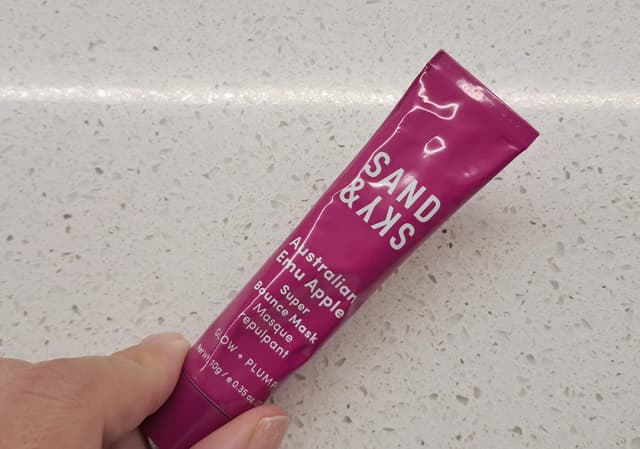
This mask leans heavily on presentation — vibrant color, fun fruit names, and trendy native botanicals — but the actual experience is far more low-key. At its core, this is a kaolin-based clay mask, but a very gentle one. If you apply a thin layer, the clay effect is barely there. It doesn’t tighten, tingle, or dry out the skin the way traditional clay masks often do. However, with a thicker application, you can feel a mild tightening as it dries — just enough to remind you there’s kaolin in the mix. Post-use, the skin does feel a little smoother to the touch, but it's more of a soft reset than a full exfoliating session. What stands out more than the clay is the hydrating base. Glycerin, propanediol, and rice starch help cushion the formula and give it a creamier feel. There are also multiple different forms of hyaluronic acid, plus jojoba seed oil, which all contribute to the moisturizing effect. Your skin ends up feeling soft and nicely hydrated. Then there’s the EMU apple complex and a handful of antioxidant-rich Australian fruit extracts, but realistically, they’re here in support roles (unlikely to deliver major effects in a wash-off mask). Despite the number of essential oils and fragrant plant extracts — orange, grapefruit, rosemary, etc — the formula doesn't come off as aggressively perfumed, and more importantly, it didn’t irritate my skin. That alone earns points for balance. If you're expecting a transformative, brightening powerhouse, this isn’t it. The performance is modest, but this is not a bad mask overall.
Dr Dennis Gross | Alpha Beta Extra Strength Daily Peel
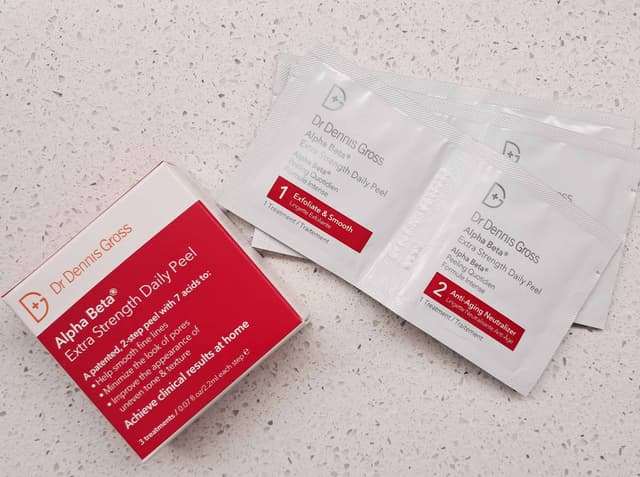
This peel doesn’t mess around. It promises maximum performance in minimum time, and it’s kind of true — if your skin can handle it. Step 1 is a cocktail of seven acids (AHAs and BHAs), including glycolic, lactic, salicylic, and mandelic. It's fast-acting, aggressive, and immediately tingly — borderline stingy. My skin feels raw after using it. This is not for beginners or the barrier-compromised; it’s a treatment for skin that’s desensitized and used to heavy-duty actives. I wouldn't use it daily — every other day for a week is my personal sweet spot — but when I do, it works. Especially on closed comedones, this thing is ruthless in the best way - and my skin looks visibly brighter and smoother with just one use. A big downside for me is the presence of a lot of alcohol in the first pad. My guess is it’s included as a penetration enhancer, since alcohol can temporarily disrupt the skin barrier and supposedly enhance absorption of actives like acids. That said, I don't think there’s any upside to using that much alcohol here. It adds dryness and barrier stress, and it’s what drags the algorithm’s score for Step 1 (alone) down to 6.8: great performance, but unnecessarily harsh delivery. Step 2 is the antidote. It calms everything down almost instantly with a blend of resveratrol, retinol, vitamin C derivatives, tocopherol, and fermented and botanical extracts. This pad feels soothing and reparative — and it better be, after what step 1 just did. It’s the reason I keep coming back to this peel instead of writing it off as too harsh. The score of pad 2 (alone) is 9.2. This is not for beginners. If you’re new to acids or still babying your skin barrier, this will eat your face. But if you're a seasoned skincare user with a high tolerance for actives and a face full of stubborn texture or closed comedones, this hits hard — and gets results. Handle with care. And follow with ceramides.
Beauty of Joseon | Glow Serum Propolis + Niacinamide
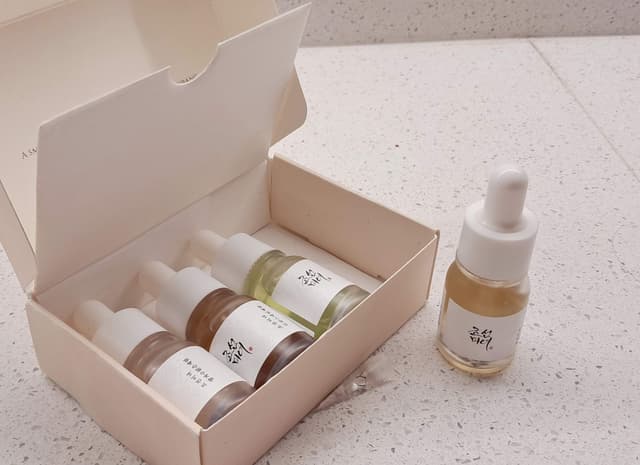
This serum markets itself as a "Glow Serum" with the added goal of controlling sebum and maintaining skin moisture — and the ingredients support that pitch, at least on paper. At the top, there’s a generous 60% propolis extract, which brings antioxidant and soothing benefits, especially good for angry, breakout-prone skin. It’s supported by betaine salicylate, a gentler BHA that is supposed to offer pore-clearing and smoothing over time — emphasis on time. If you're expecting instant clarity or radiance, you’ll probably be underwhelmed. I didn’t notice a dramatic “glow,” but to be fair, BHA doesn't seem to do much for me, so that might be a skin-specific thing. There’s also niacinamide at a reasonable, non-aggressive dose (2%), which helps with oil regulation and long-term skin tone improvement, plus centella, tea tree, turmeric, and other botanicals that offer a bit of calming and antimicrobial support. Texture-wise, it's a jelly-like serum that spreads well and isn't tacky once it settles. It layers easily, plays nice with other products, and doesn’t sting even on slightly irritated skin. While it’s not one of those serums that gives you instant gratification, it’s a good option if you want to include a niacinamide serum in your routine — especially if your skin leans oily and sensitive. You might not (who am I kidding, you won't) get a glow that stops traffic, but if your goal is balanced, less-reactive skin, this one will earn its place over time.
Naturium | Niacinamide Cleansing Gelée 3%
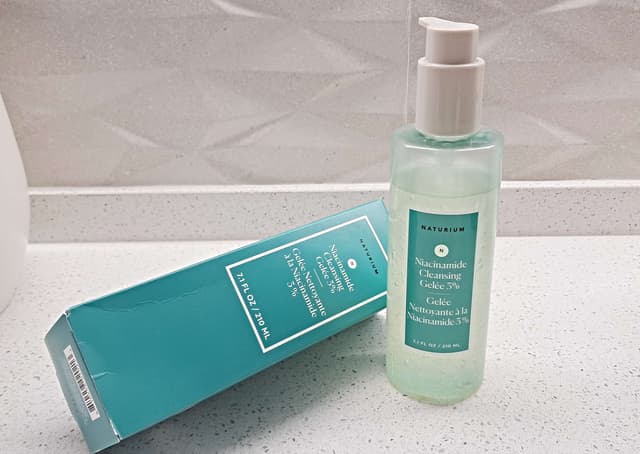
This is the kind of cleanser that feels like it was made for sensitive skin — low-foaming, ultra gentle, hydrating — even if it never actually says so on the label. With 3% niacinamide and a solid mix of humectants like glycerin and sodium hyaluronate, this gelée doesn’t just cleanse — it leaves your skin feeling moisturized while cleansing. And it doesn’t leave a film, nor does it feel like an oil - not even a cleansing cream, just a hydrating gelée. Despite containing sodium ascorbyl phosphate (a derivative of vitamin C) and camu camu extract — both common players in “brightening” formulas — this one doesn’t make any bold radiance claims. Which is honestly refreshing. Neither ingredient is going to sit on the skin long enough to produce visible brightening effects — but that doesn’t usually stop brands from making far-fetched claims. What’s most surprising, though, is how effective it is. For something that feels so gentle, it gets through makeup surprisingly well. You’ll still want micellar water if you intend on removing a full beat, but on most days, this comes very close to a cleansing balm — and that’s saying something. In short, it's hydrating, non-stripping, and quietly competent.
SKIN1004 | Madagascar Centella Probio-Cica Intensive Ampoule
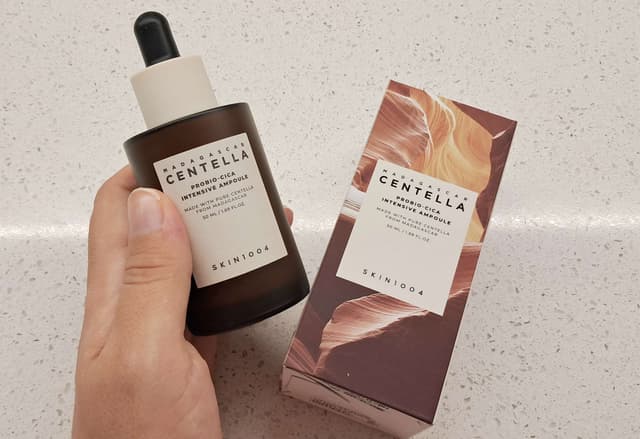
Marketed as a “Probio-Cica Ampoule”, this serum leans heavily into barrier repair and soothing care, and the formula backs that up. You’ve got Centella Asiatica extract and its key actives — madecassic acid, asiaticoside, asiatic acid — for calming inflammation, plus a solid blend of niacinamide, ceramide NP, phytosphingosine, macadamia oil, and panthenol to deeply moisturize and support the skin barrier. And then there’s the “Probio” part — referring to Lactobacillus ferment, known to help soothe skin, strengthen the barrier, and support the skin microbiome. It appears lower down the list, so it's likely present in moderate amounts — not the star of the formula, but a supporting player that fits the barrier-care theme. The texture is a standout: milky, midweight, and soothing on contact — not too watery but not sticky either. If you have dry or sensitized skin, this is exactly the kind of serum that feels like a sigh of relief - which I'm starting to find is a common theme among K-beauty serums. It glides on, sinks in, and with continued use, leaves skin looking plump and quenched. The results don't look dramatic, but they feel dramatic: it’s not here to resurface or give you a glow overnight, it’s here to hydrate, protect, and reinforce — and it does that beautifully. If you have barrier-compromised or very dry skin, this is a top-tier option. In short, a smartly formulated ampoule that’s more than just marketing fluff. This one earns its “cica” badge fair and square.
Byoma | Ultralight Face Fluid SPF30

This sunscreen makes a great first impression. The formula is loaded with barrier-repair ingredients and hydrating agents, and a few standout actives like astaxanthin — the bright orange antioxidant they proudly pitch as being 6,000x more powerful than vitamin C. The consistency is also promising: a super-fluid cream that spreads like water — but once applied, the finish is where things unravel. Despite the airy application, it leaves a noticeable film and a persistent shine that never fully settles - in fact, it gets worse as the day progresses. The feel is distinctly old-school — down to the classic SPF smell — and on my skin, it behaves like one too, congesting my pores, just like traditional sunscreens always have. And that’s frustrating, because there’s so much to like on paper. You’ve got a strong, broad spectrum UV filter combo (octocrylene, homosalate, avobenzone, etc.) paired with ceramide NP, phytosphingosine, cholesterol, sodium hyaluronate, bisabolol, tocopherol, beta-glucan — all excellent for moisture retention, barrier support, and anti-inflammatory action. And of course, astaxanthin, one of the most promising antioxidant additions to modern skincare. Byoma is clearly aiming for more than just sun protection here — this is a skin-caring SPF designed to repair and defend, not just block UV rays. And my algorithm reflects that: it scores almost perfectly based on ingredients alone. But for me, it’s just too greasy and unfortunately feels like a throwback — despite the modern formulation. I wanted to give it a "great" but can't give it more than a "good". Such a shame.
Farmacy | Honey Halo Ultra-Hydrating Ceramide Moisturiser
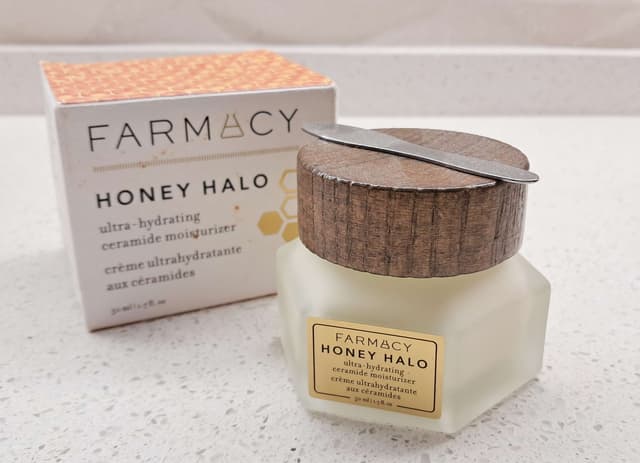
The name of this product sets some expectations: honey, hydration, and barrier repair all in one comforting-sounding jar. And while it doesn’t explicitly market itself as a post-actives cream (i.e. something to use after strong ingredients like retinoids or exfoliating acids), that’s exactly how I use it — and it works. It’s definitely rich, but not balmy or greasy. It spreads smoothly, sinks in without fuss, and leaves my skin feeling covered but not coated, if you get what I mean. On weeks where I’ve pushed things a bit too far with actives, this goes on like a truce offering. The formula is doing a lot of heavy lifting to earn that feeling. You get a blend of ceramide NP, shea butter, glycerin, panthenol, betaine, and bisabolol, all focused on restoring moisture and supporting the barrier. There’s also a trio of bee-themed ingredients — honey, propolis, and royal jelly extract — which, while more about the vibe than hardcore performance, do bring mild soothing and antimicrobial benefits. The result is a formula that doesn’t just sit on the skin — it actually helps it recover. Now, the one downside: the packaging. This cream comes in a clear glass jar. It's heavy and thick and looks premium, sure — and although the little spatula (that attaches magnetically to the lid, by the way, so you never lose it) helps prevent microbial contamination, there is still a risk of oxidation for some ingredients. Specifically, sea buckthorn oil, which might degrade when exposed to light and air. It's not the worst formula to be offered in jar packaging, but a more protective container would’ve made more sense.
Nip & Fab | Vitamin C Fix Tonic

This is marketed as a “vitamin C tonic” — something to brighten and illuminate, with the added bonus of being antioxidant-rich. In reality, it’s an exfoliant with a citrusy name and a misleading label. The formula puts lactic acid right up top — which explains why this works so well on clogged pores, especially whiteheads. It’s particularly effective for me in that sense: I use it once on congested skin, and it’s halfway cleared by the next day. But it’s also drying, especially if you’re using it like a toner. To their credit, the instructions do say to use it only 2–3 times a week, but still — I’d prefer if they were more forthcoming about the fact that this is actually an exfoliant, so I can moisturize my skin accordingly. If your barrier’s even mildly compromised, this can tip it over the edge. And as for the “vitamin C”? Ascorbic acid shows up after phenoxyethanol, meaning it’s present at less than 1% — legally required, since phenoxyethanol is capped at 1% (and often used at a much lower concentration), and everything after it is present in smaller amounts. So the antioxidant claim is mostly label dressing. To make matters worse, the product comes in transparent orange plastic, which offers zero meaningful UV protection — great for shelf visibility, terrible for ascorbic acid stability. There are a few nice touches — panthenol helps buffer some irritation, and there’s a whole fruit basket of antioxidant extracts (green tea, pomegranate, goji, etc.) — that would be more impressive if they weren’t all tucked away at the end of the list. You’re getting exfoliation with a dash of marketing. Bottom line: call it what it is — a lactic acid exfoliant with a brightening pitch. It’s useful for clearing congestion, but don’t expect a vitamin C serum in toner form. And don’t use this every day unless you like the feeling of your skin quietly resenting you.
Round Lab | Birch Juice Cleanser

This is one of those cleansers I reach for when my skin is sensitized, reactive, or just not in the mood for drama. It’s gentle, non-stripping, and feels safe — which, when your barrier is already annoyed, is exactly what you want. It does a decent job of cleansing — not enough for a full face of makeup (and to be fair, it doesn’t claim to), but definitely enough for sunscreen, skincare, and a light base. It doesn’t leave my skin feeling tight or dry, which is a win. That said, it doesn’t feel hydrating either — it’s not one of those cleansers that leaves your face feeling like it has an oily film on top, but it doesn't feel freshly hydrated either. My skin just feels neutral: clean, but not squeaky. Comfortable enough, I would say. The formula leans into that gentle, barrier-safe approach. You’ve got a blend of mild surfactants like sodium cocoyl alaninate and cocoyl isethionate (no SLS in sight), plus a solid cast of humectants — glycerin, glyceryl glucoside, hyaluronic acid — to keep things cushiony. There’s also artemisia, birch sap, and quillaja bark extract, which all sound great on the label and likely add a bit of antioxidant and soothing support, but let's face it, this is a cleanser, so the amount of time those antioxidants are in contact with the skin isn't enough for anything other than a minuscule effect. The addition of pine oil might raise an eyebrow for the very sensitive, but in my experience, it doesn’t cause any irritation. This isn’t a “deep-clean” or “miracle glow” kind of product — and it doesn’t try to be. It’s just a simple but well-behaved cleanser.
Beauty of Joseon | Glow Deep Serum Rice + Alpha Arbutin
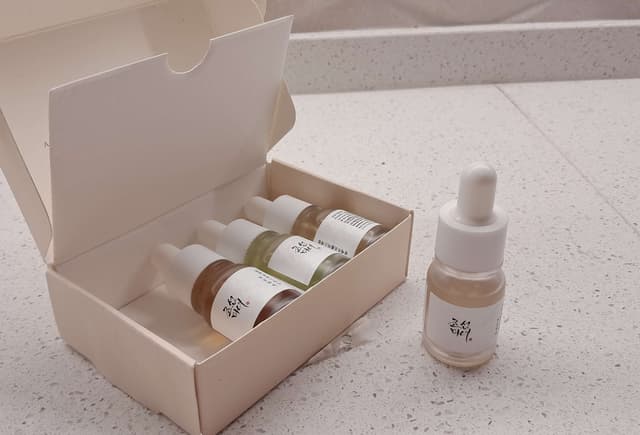
Beauty of Joseon's Glow Deep serum isn’t the kind of product that gives you instant glow or makes your skin look dramatically better overnight. If you’re used to the fast payoff of a vitamin C serum, this one will feel more... restrained. But used consistently, it does make a difference. Used consistently, I noticed a subtle evening of skin tone and a reduction in redness — not dramatic, not “wow, what a facial,” but a visible improvement nonetheless. My skin looks calmer, less reactive, and more balanced. I’m not glowing per se, but I’m not dull either. Somewhere in that sweet middle where skin just looks healthy. The texture is gel-like but watery, spreads effortlessly, and disappears into the skin without residue or tackiness. It layers beautifully with other products and, like other Beauty of Joseon serums I’ve tried, it’s absurdly well-behaved — no irritation, no stinging, no drama. These serums genuinely seem designed for reactive, overstimulated skin that needs a break from the constant assault of actives. The formula backs that up. You’ve got alpha-arbutin, which helps suppress melanin production to fade dark spots, paired with niacinamide, which regulates pigmentation, strengthens the barrier, calms redness, and generally does basically everything short of filing your taxes. They’re buffered by panthenol, trehalose, and methyl gluceth-20 to keep the barrier happy. And then there’s the rice bran water, plus a buffet of grain extracts (barley, corn, sesame, soybean, mung bean) that add antioxidant support — and, let’s be honest, a bit of “wholesome, skin-loving botanicals” marketing polish — whether or not they’re pulling much weight on their own. It’s not your instant-gratification glow serum — but for skin that’s tired, sensitive, or just over it, this is a steady, supportive, quiet achiever.